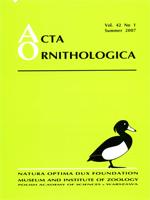European Robins are found at “La Font Roja” Natural Park in SE Spain throughout the year. Analysis of recaptures of individually marked birds during 3 years strongly suggests that individuals breeding in the park abandon it during the winter, while a new wintering population occupies the park between November and March. We found that during 5 weeks in April and 3 weeks in October the two populations overlapped. We also analysed the biometry of the “local” (breeding) and “wintering” populations. The local population had significantly shorter wings, and longer tails and tarsi than the wintering population. In both populations, juveniles had shorter wings and longer tails than adults, but tarsus length did not differ between age classes. Among the local birds, males had longer wings and tails than females, but tarsus length did not differ between sexes (sex could not be determined in the wintering population). Biometric analyses supported the hypothesis of the occurrence of two separate populations in the study area, and also that the migratory tendency (as derived from wing and tail lengths) was higher among the wintering birds.
How to translate text using browser tools
1 July 2007
Seasonal Interchange of the European Robin Erithacus rubecula Populations in an Evergreen Holm Oak Forest
Mónica Domínguez,
Emilio Barba,
José L. Cantó,
Germán M. López,
Juan S. Monrós

Acta Ornithologica
Vol. 42 • No. 1
July 2007
Vol. 42 • No. 1
July 2007
Biometry
Erithacus rubecula
European Robin
flight-related morphology
migratory tendency
population replacement
wintering quarters




